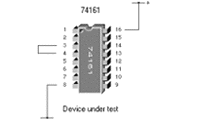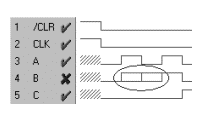
PCB test — locate faulty digital ICs easily with In Circuit Functional Test
|
||
| Printer Friendly Version | |
 |
Application Note 111
PCB test — locate faulty digital ICs easily with In Circuit Functional Test |
| Printer Friendly Version | |
| Sophisticated software device
simulation techniques in modern ICT Fault Locators now
allow rapid and effective location of faulty digital ICs
without removal from circuit. What
is ICT? The
ICT Fault Locator Building
a reference device
|
|
 Short detected between pins 3 and 4 |
The Links diagram Many faults are due to wrong connections between IC pins, open or short links, pins stuck high or low, etc. The fault locator displays shorts and opens in the links diagram. In the example to the left, the fault locator has detected an unexpected link (i.e. a short) between pins 3 and 4 of the IC. |
 The result of the short between pins 3 and 4 |
The Logic diagram Detail from the resulting logic waveform diagram is shown below. Reference and DUT waveforms are shown in different colors for easy identification - in this case the ringed area shows the effect of the short on the device behavior. The short would now be rapidly pin-pointed. |
| ICT's unique ability to simulate device in-circuit behavior and its graphical display of logic problems provide a powerful tool for rapid trouble-shooting down to component level. If you have a trouble-shooting technique you would like to share with other Polar fault locator users please fax or email Polar Instruments on the number below. | |
Polar Instruments Ltd polarinstruments.com Tel: +44 1481 253081 Fax: +44 1481 252476 © Polar Instruments 2002 |
 |
| © Polar Instruments 2002. Polar Instruments pursues a policy of continuous improvement. The specifications in this document may therefore be changed without notice. All trademarks recognised. | |